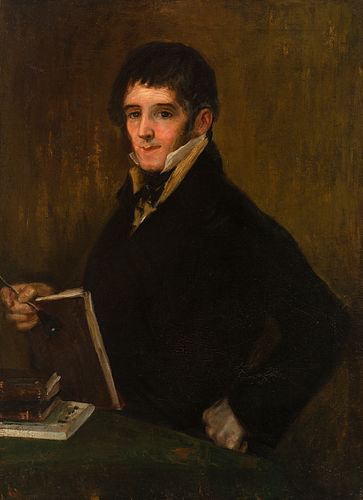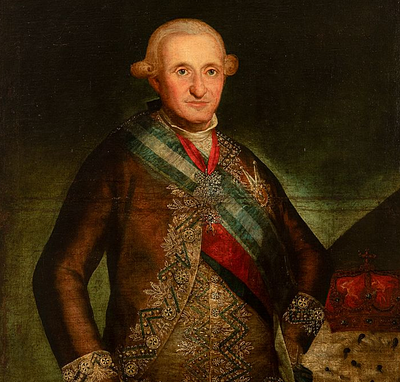Spanish school; first half of the 19th century. "Portrait of the engraver Rafael Esteve". Oil on canvas.
Lot 39
About Seller
Setdart Auction House
Carrer Aragó 346
Barcelona
Spain
Setdart Subastas was born in 2004 and is currently the first online art auction in Spain with solidity, prestige and reliability guaranteed by our more than 60,000 users. Setdart has a young, dynamic and enterprising team ready to successfully manage the purchase and sale of art works through custom...Read more
Estimate:
EUR€7,000 - EUR€9,000
$7,216.49 - $9,278.35
Absentee vs Live bid
Two ways to bid:
- Leave a max absentee bid and the platform will bid on your behalf up to your maximum bid during the live auction.
- Bid live during the auction and your bids will be submitted real-time to the auctioneer.
Bid Increments
| Price | Bid Increment |
|---|---|
| EUR€0 | EUR€10 |
| EUR€200 | EUR€25 |
| EUR€500 | EUR€50 |
| EUR€1,000 | EUR€100 |
| EUR€3,000 | EUR€200 |
| EUR€5,000 | EUR€500 |
| EUR€10,000 | EUR€1,000 |
| EUR€20,000 | EUR€2,000 |
| EUR€50,000 | EUR€5,000 |
About Auction
By Setdart Auction House
Sep 22, 2021
Set Reminder
2021-09-22 09:30:00
2021-09-22 09:30:00
America/New_York
Bidsquare
Bidsquare : 22nd September - ARAS JÁUREGUI Private Collection - Old Masters, 19th & 20th Century
https://www.bidsquare.com/auctions/setdart-auction-house/22nd-september---aras-j-uregui-private-collection---old-masters-19th-20th-century-7427
ARAS JÁUREGUI Private Collection - Old Masters, 19th & 20th Century Setdart Auction House sofia@setdart.com
ARAS JÁUREGUI Private Collection - Old Masters, 19th & 20th Century Setdart Auction House sofia@setdart.com
- Lot Description
Spanish school; first half of the 19th century. "Portrait of the engraver Rafael Esteve". Oil on canvas. It has an inscription on the back of the attribution of Don Estévez Lorenzo to Francisco de Goya. Measurements: 90 x 65,5 cm; 104 x 77 cm (frame). This work faithfully follows the portrait of the engraver Rafael Esteve, painted by the Aragonese master Francisco de Goya y Lucientes, which currently belongs to the Museum of Fine Arts in Valencia. This is where it ended up, after being donated by the portrait's descendants to the Royal Academy of San Carlos in Valencia in 1818. In the work, the engraver can be seen sitting on a yellow upholstered chair next to his table. In his right hand he holds the burin and in this work an artist's notebook, instead of the copper plate he holds in the portrait in the Valencia Museum. The upright attitude of the sitter is striking, indicating his pride in his profession, as well as his artistic relevance. His black coat, white shirt and tie lend a sobriety that contributes to the idea of his social position. In addition, his face looks directly at the viewer with a slight smile, showing his confidence and social recognition. The work not only reflects aspects of Goya's mastery, but also shows the great friendship that existed between the painter and the engraver, who met thanks to Agustín Esteve y Martín, Rafael's cousin, with whom Goya had worked. This relationship was established on a personal and even professional level, as it is believed that Rafael Esteve worked with Goya on the series of engravings of the Tauromaquia. In addition, Goya portrayed the engraver on several occasions, an example of which is another work in the Museo Lázaro Galdiano, which belonged to the artist's goddaughter Rosario Weiss. Rafael Esteve (Valencia, 1772 - Madrid, 1847) belonged to a family of artists. His father was the sculptor José Esteve Bonet and his uncle, the painter Agustín Esteve. He received his artistic training at the San Carlos Royal Academy of Fine Arts in Valencia, but later moved to Madrid, where he continued his studies at the San Fernando Royal Academy of Fine Arts. During the reign of King Charles IV, he collaborated with the royal intaglio artists. In 1799 he was appointed Court Engraver and produced portraits of the Royal Family, based on drawings by his uncle Agustín and Francisco Goya. During the War of Independence he lived in Cadiz. Once the war was over, he was able to fulfil his wishes to continue his education in France and Italy. In 1839, he received the greatest honour of his career in the form of a gold medal at the Exposition des produits de l'industrie française. He was also decorated with a cross in the Order of Charles III and appointed Honorary Director of the Academy of San Carlos and "Academician of Merit" at the Academy of San Fernando and a corresponding member of the Academy of Paris.
- Shipping Info
-
In-house shipping available. Please inquire at admin@setdart.com.
-
- Buyer's Premium



 EUR
EUR CAD
CAD AUD
AUD GBP
GBP MXN
MXN HKD
HKD CNY
CNY MYR
MYR SEK
SEK SGD
SGD CHF
CHF THB
THB

















